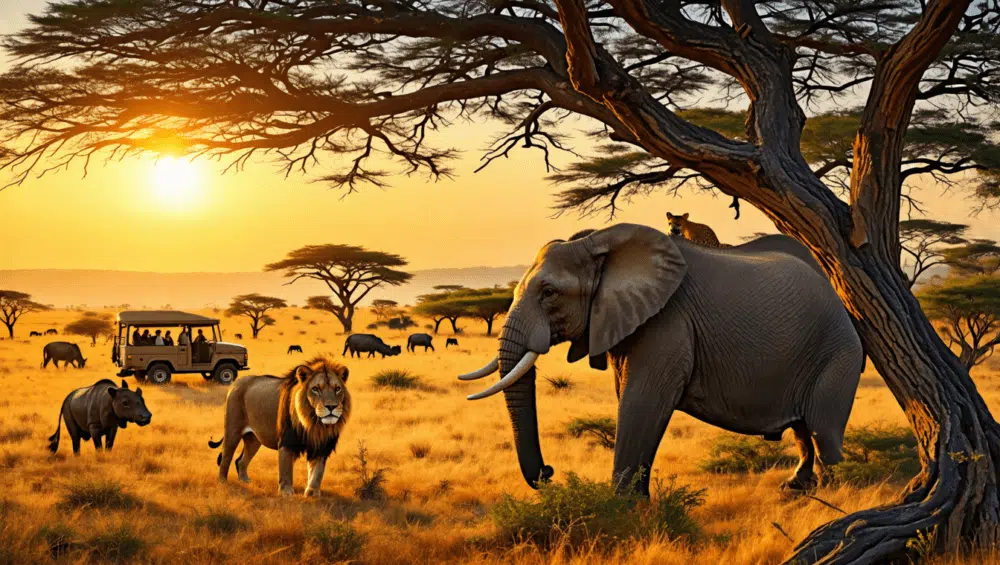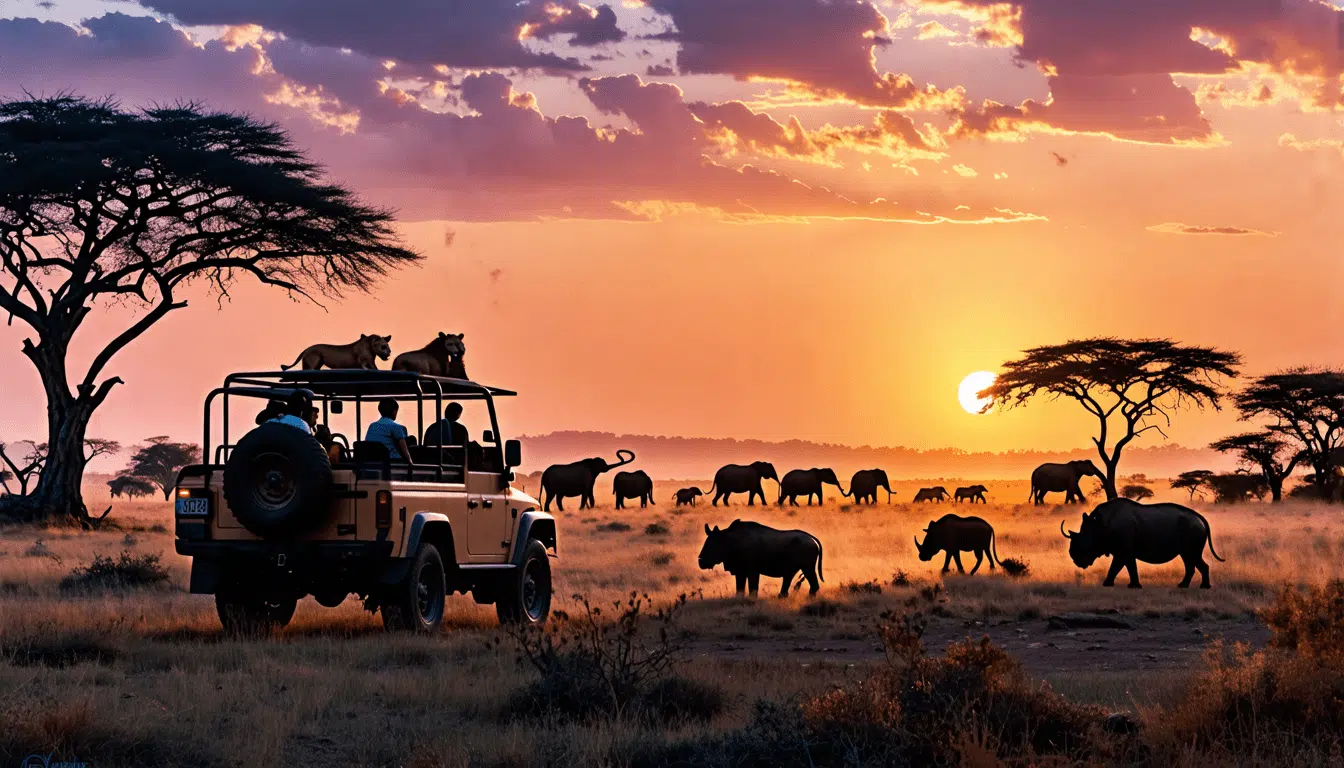Embarking on an African Safari Adventure: Meet the Big Five
Oh, the thrill of going on a safari! Picture yourself feeling the sun’s warmth as you traverse the breathtaking landscapes of Africa, your heart pounding with excitement and anticipation. What exactly are we eagerly venturing out to see? The illustrious Big Five. These aren’t just any animals—this quintet includes the African Elephant, Lion, Leopard, Rhinoceros, and Cape Buffalo, each with its own flair and a legacy that beckons adventurers from around the world. But why ‘Big Five,’ you might ask?
The Origins of the Big Five
So, here’s a little nugget of history. The term Big Five was coined by big game hunters back in the day, referring not to the size of the animals but to the difficulty in hunting them. Fortunately, we’ve evolved past viewing these magnificent creatures as mere trophies. Today, they stand as enduring symbols of Africa’s rich wildlife heritage, drawing thousands of eco-conscious tourists who seek to marvel at them through a camera lens rather than a rifle scope.
But let’s get real for a moment. Why is seeing the Big Five so significant? Well, it’s more than just ticking off an item on your bucket list. For many, a safari is a unique dance between nature and human curiosity, a journey that promises an encounter with wildlife in its purest form. The Big Five become your focal point, combining cultural allure and a deeper connection to the magical world of African wilderness.
Are you ready to delve into this world where the roar of the lion might just be your morning alarm and the sight of elephants your evening highlight? Let’s start our safari adventure to meet these splendid creatures and discover where you can cross paths with them. Who knows, maybe you’ll uncover a story that becomes a cherished memory, a testament to your African expedition.
“`html
Introduction to Africa’s Big Five
Oh, the thrill of cooking breakfast with a backdrop of the African savannah! But let me take you back to where it all began—the term Africa’s Big Five. You’ve probably heard it thrown around in wildlife shows or maybe your adventurous friend’s travel blog. But what does it mean? And why do these five animals stand on the pedestal of safari fame?
What Does the Big Five Mean?
In the world of African wildlife, the Big Five refers to the African Elephant, African Lion, African Leopard, Rhinoceros (both Black and White), and Cape Buffalo. But here’s the thing—it’s not their size that earns them this title. Rather, it’s the difficulty and danger hunters faced when pursuing these majestic creatures. Spoiler alert: photography is now the preferred form of capture!
The Hunter’s Legacy
Back in the day, big game hunters weren’t interested in Instagram likes but rather bragging rights. The term Big Five was coined to refer to the five most challenging animals to hunt on foot. Now, let’s pause to think about that. Can you imagine the nerve required to face down an unpredictable rhino? Or the boldness of approaching a pride of lions slyly resting in the shade? These hunters were seeking adrenaline, and encounters with the Big Five offered it in spades.
The Cultural and Tourism Significance
Fast forward to today, and these very animals have become the cornerstone of African safaris. They’re not just part of the landscape—they are the stars of the show. The economic and cultural value they bring is immense. Safaris centered around the Big Five help sustain local economies, provide jobs, and support conservation efforts. They transform vast ecosystems into living classrooms where tourists can connect with nature and learn the profound importance of wildlife preservation.
And let’s be honest, who doesn’t want a picture by the waterhole with elephants taking a dip, right?
So, what draws us to these formidable five? Is it their sheer presence, their unpredictable behavior, or perhaps their role at the heart of powerful ecosystems? Maybe it’s just the bragging rights of having seen them in their natural habitat—something to boast about over dinner parties or hesitant bar conversations.
Regardless, when you step into the realm of Africa’s wilderness, and the possibility of encountering the Big Five becomes real, you’ll find it’s an experience like no other, drawing you into a world where nature reigns supreme, and you are but a humble visitor. As you plan your safari adventure, understanding the legacy and significance of the Big Five will enrich your journey beyond even the most vivid dream. After all, each encounter with these magnificent creatures will etch an indelible memory into the annals of your travel tales.
“`
The Big Five Animals: Characteristics and Habitats
Embarking on a journey to encounter Africa’s Big Five is like setting out on a personal quest—each animal possesses a unique allure, and each encounter feels almost mythical. So, who are these majestic creatures that magnetize travelers from across the globe? Allow me to take you on a journey through the wild and wondrous worlds of the African Elephant, African Lion, African Leopard, Rhinoceros, and Cape Buffalo. Buckle up; it’s going to be an extraordinary ride!
African Elephant: The Gentle Giant
If you’ve ever seen an African Elephant in person, you know they are truly magnificent—huge yet graceful in their lumbering way. Renowned for their sheer size and social complexity, these giants are the largest land mammals on Earth. But elephants are not just about size; they exude intelligence and emotion like few others. Ever seen one mourn a fallen family member or rejoice in their waterhole antics? It’s an experience that will change you.
Elephants thrive in diverse habitats, from the Savannahs of East Africa to the lush forested regions in the Central and West. You’re most likely to spot them in Tromp through Uganda’s Queen Elizabeth National Park or Kenya’s Amboseli National Park, often seen flapping their vast ears to keep cool under the hot African sun. Remember, these are social animals, always moving in herds with complex matriarchal societies—think of it like a matriarchal dinner table, only a lot bigger and fuzzier.
African Lion: The Majestic Symbol of Power
Call me melodramatic, but hearing a lion’s roar echoing across the Savannah is something you’ll never forget. As the top predator in the African ecosystem, the lion embodies strength and majesty. These are social animals too, unlike other cats, living in prides that can be seen lazily basking under acacia trees or energetically hunting in a coordinated manner—a fascinating display of teamwork. And let’s not even start with those photogenic ‘sunset shots’ capturing lions against the Serengeti horizon.
Lions generally prefer the grasslands and savannahs of East and Southern Africa, where the food supply is abundant. Head over to the Serengeti National Park in Tanzania or the Masai Mara in Kenya for prime lion-viewing experiences. Trust me, seeing a lion in action takes your basic zoo visit to the next level—no cage bars, just the vast, open, wild world.
African Leopard: The Elusive Beauty
If you’ve got your heart set on spotting the African Leopard, prepare for a game of hide and seek. Elegance personified, leopards are solitary, nocturnal creatures who blend seamlessly into their surroundings. Their spotted coats are celebrated symbols of stealth and grace, and if you’re lucky enough to spot those luminous eyes at night, you’ll feel a tingle of thrill run down your spine.
Leopards are adaptive survivors and can inhabit a range of environments from dense forests to dry deserts. Some of the best places to try your luck are Kruger National Park in South Africa or the Okavango Delta in Botswana. Keep your binoculars handy, because you might find them lounging high in trees, none the wiser of your presence. After all, who doesn’t enjoy a good tree nap?
Rhinoceros: The Armored Helper
Rhinos take the spotlight with their armor-like skin and intimidating horns. Sadly, these beautiful beasts are often under threat from poaching, reminding us of our responsibility to protect them. Did you know there are two distinct types of rhinos in Africa—the Black Rhino and the White Rhino? White Rhinos, contrary to what their name suggests, are not actually white, and Black Rhinos are more distinguished by a pointed upper lip. A little confusing, right?
Rhinos can often be found in grassland and savannah areas of both South Africa and Namibia. For the best chance of witnessing these hefty creatures, you can’t go wrong with a visit to Hluhluwe-iMfolozi Park in South Africa or Namibia’s Etosha National Park. Be sure to have your camera ready; you’ll want to capture these living relics of the prehistoric.
Cape Buffalo: The Unyielding Spirit
Never underestimate the Cape Buffalo, often regarded as the gutsiest of Africa’s Big Five. These robust creatures are like a powerful motorbike gang of the savannah, feared by lions and carrying an attitude that commands respect. They have a reputation for unpredictable behavior, which, ironically, adds an air of mystery and excitement to any sighting.
Cape Buffalos inhabit varied environments, including savannahs, swamps, and floodplains throughout Sub-Saharan Africa. They congregate in large herds, and you can catch them grazing in many regions, with South Africa’s Kruger National Park and Zambia’s South Luangwa National Park being prime spots. Just remember: it’s advisable to admire them from a safe distance—you don’t want to overstay your welcome with this crowd.
As you wander through these incredible landscapes, each encounter with the Big Five becomes a story in your travel diary, a moment that connects you with the raw, untamed beauty of nature. Who will be your favorite, I wonder?
Top Safari Destinations to Spot the Big Five
Imagine this: you’re on a vast African plain, the air electric with adventure. Suddenly, a pride of lions strolls into view, leaving you speechless. Where do you find this magic? Let’s dive into the heart of Africa’s legendary safari destinations where the Big Five roam free. Shall we?
South Africa: Kruger National Park
Ah, Kruger! The crown jewel of South African safari experiences. Picture rugged landscapes teeming with wildlife and abundant Big Five sightings. This park is renowned globally, and for good reason. With an expansive area larger than some small countries, your safari will surely never have a dull moment. The dry season, from May to September, is prime time; wildlife congregates around waterholes, making them easier to spot.
So, what’s the best way to explore? Guided tours, of course! They don’t just increase your chances of impressive wildlife encounters; they’re also akin to a real-life National Geographic with expert rangers as your narrators. Who wouldn’t want that?
Kenya: Maasai Mara National Reserve
Kenya’s Maasai Mara isn’t just another safari destination; it’s a rite of passage for wildlife enthusiasts. Why, you ask? The annual Great Migration sees millions of wildebeest and zebra crossing the Mara River, with hungry predators in tow. Exciting, right?
While Maasai Mara is a year-round destination, July to October is unparalleled thanks to the migration spectacle. Imagine roaming endless savannahs chaired by majestic African lions, and you’ve only scratched the surface. Harness the thrill on a hot air balloon safari at dawn—just a hint of luxury amidst the wild.
Tanzania: Serengeti National Park and Ngorongoro Crater
I’ve never met anybody who regretted a visit to Tanzania’s Serengeti or the Ngorongoro Crater. Not only does the Serengeti host the other half of the Great Migration; it’s also a playground for lions, leopards, and elephants. Let’s not forget Ngorongoro—a UNESCO World Heritage Site that’s basically the world’s largest wildlife showroom.
For a satisfying Big Five encounter here, the dry season—between June and October—is your best bet. Fancy a road trip through Africa’s most epic landscapes? The Northern Circuit safari offers a whirlwind yet profound journey through these natural wonders.
Botswana: Chobe National Park and Okavango Delta
Next stop, Botswana—a country that’s the very definition of unspoiled wilderness. Imagine cruising down the Chobe River, where elephants line the banks like sentinels. Chobe National Park boasts the highest elephant concentration on the continent and a good chance to spot the other members of the Big Five too.
Then there’s the Okavango Delta, a lush Eden of water and wildlife, best explored via mokoro (traditional canoe) during the flood season from June to August. Here, hippos might serenade you, while secluded lodges offer front-row seats to the action. Perfect, no?
Namibia: Etosha National Park
What’s Namibia got going for it? Well, Etosha National Park’s sheer uniqueness sets it apart. Dominated by a massive salt pan, this otherworldly landscape contrasts starkly with the verdant plains of the delta. Yet it’s teeming with life—more so around waterholes during the dry season, which runs from May to October.
Etosha might not have the stereotypical safari look, but it offers self-drive enthusiast’s flexibility and intimacy with nature. Plus, there’s nothing quite like the sight of a solitary black rhino silhouetted against the setting sun, wouldn’t you agree?
Choosing the Right Safari for You
So how do you choose? It depends on what you’re after—vast herds, scenic landscapes, solitude in the wild? South Africa’s guided comforts call to first-timers, while seasoned adventurers might revel in Botswana’s untamed beauty. Whichever path you take, remember the golden rule: plan ahead, and book in advance! This isn’t just a trip; it’s a journey into a world where nature remains king. It’s time for you to be part of that world.
Ready to grab those binoculars and set off on your dream safari? What are you waiting for? Africa’s Big Five won’t wait forever!
Tips for a Successful Big Five Safari Adventure
Alright, you’re all set to embark on a journey of a lifetime, ready to witness Africa’s majestic Big Five in their natural habitat. But wait! How do you ensure this isn’t just an adventure, but a grand safari symphony played out in the wild? Let me walk you through some essential tips that aren’t just about packing the right gear, but also about embracing a responsible and unforgettable experience.
Planning Your Safari: Itinerary, Accommodations, and Guides
Imagine this: You’ve saved up for this trip, and you arrive in Africa bursting with excitement. But then—disaster! Your itinerary is either too crammed or you’ve booked accommodations nowhere near the action. To avoid such pitfalls, start by digging into safari planning tips—and trust me, you’ll thank me later.
First thing’s first, tailor your itinerary. Choose a balance between wildlife viewing and downtime. Remember, spotting each of the Big Five could take several days as it’s not just about ticking boxes off your list. It’s about savoring each moment. Research the best times of year based on your selected location. For instance, the dry season is prime for viewing as animals gather around watering holes. South Africa’s Kruger National Park or Kenya’s Masai Mara anyone?
When it comes to accommodations, picture a spectrum from luxury lodges to budget campsites. Consider your comfort necessities, but also think about the unique experiences each option offers. Ever stayed in a tent with a chorus of nocturnal wildlife serenading you to sleep?
And don’t forget about guides—your human link to deciphering nature’s intricate tapestry. A knowledgeable guide enhances your experience tenfold. They not only have a sixth sense for animal spotting but can also regale you with local knowledge that turns a great trip into an extraordinary one.
Responsible Tourism: Ethical Wildlife Viewing and Conservation
Here comes the heart of our adventure: viewing Africa’s wildlife responsibly. Ethical wildlife viewing is more than a buzzword—it’s a necessity. Do you remember the last time you were in an art gallery and someone set off the flash on their camera, disrupting the ambiance? The same goes for the bush. Respect the natural environment, keep a safe distance, and never, ever feed the animals.
Moreover, consider the role of conservation in your travel arrangements. Support eco-friendly lodges that invest in local communities and wildlife protection. By doing so, you’re helping to protect these magnificent creatures for future generations. And yes, those rhinos will thank you too—if they could.
Packing Essentials and Health Considerations for a Safe Safari
Pack smart, my friend! The African bush can be just as unpredictable as a toddler hyped up on sugar. Essential safari gear will see you through from dawn to dusk. Lightweight, neutral-colored clothing is a must—trust me, you don’t want to be the only one attracting mosquitos at the evening campfire.
Binoculars are your trusty sidekick. Not all wildlife likes to pose for selfies at close range, so spotting scopes or a decent pair of binoculars can elevate your view-experience incredibly. And hey, let’s scout the horizon like a pro.
Health is another priority to consider. Consult with a travel doctor to discuss necessary vaccinations and medications, such as malaria prophylaxis. A musical symphony of mosquito buzzes is enchanting, but only when you’re protected.
Lastly, don’t forget your favorite snacks. With unpredictable schedules and sometimes long spans between meals, having something munch-worthy is never a bad idea. Just keep them sealed up to avoid surprising visitors in your tent.
By mastering these tips and fully immersing yourself in the experience, your Big Five safari will not only meet but exceed every expectation. Remember, the beauty of a safari lies not just in what you see but how you see it. Are you ready to embark on your own epic safari adventure?
Conclusion: Embrace the Wild and Unforgettable Experience
So, there you have it—Africa’s Big Five, a quintet that has long captured the hearts and imaginations of adventurers from every corner of the globe. As you set out on your safari adventure, whether you’re a wildlife enthusiast or just someone with a wanderlust as vast as the African savannah, I hope this guide helps you make the most of your journey. The Big Five are more than just animals on a checklist; they’re a symbol of Africa’s rich natural heritage, a reminder of why conservation efforts are so crucial.
Picture yourself there, amidst the golden plains of the Serengeti or the lush greenery of Kruger National Park, witnessing an elephant parade or a lion pride lounging in the sun. Each encounter is an awe-inspiring moment that brings with it a newfound appreciation for the intricate web of life.
But let’s not forget: our safari adventures carry a responsibility. Ethical considerations and sustainable practices aren’t just buzzwords; they are a necessary approach to ensure that these magnificent creatures and their habitats continue to thrive. Remember to pack your binoculars, but don’t forget to carry a mindset of respect and care, too.
Is there any trip more thrilling, more enlightening, or as rich in stories to tell later on? As you embark on this safari holiday, you’re not just seeking out the Big Five—you’re stepping into a world filled with extraordinary settings and unforgettable experiences. And who knows, maybe you’ll return with a new sense of awe for our planet—or at least with a tale or two that will have everyone hanging on your every word.
The wild is calling; answer it with open eyes and a full heart.









